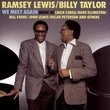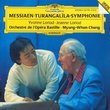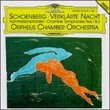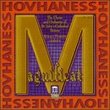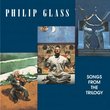| All Artists: Charles Ives, Simeon Butler Marsh, Lowell Mason, John R. Sweney, Joseph Philbrick Webster, Heinrich Christopher Zeuner, Michael Tilson Thomas, Richard Webster, Mary Sauer Title: Ives: Symphonies Nos. 1 & 4/Hymns Members Wishing: 2 Total Copies: 0 Label: Sony Original Release Date: 1/1/1991 Re-Release Date: 3/22/1991 Genres: Pop, Classical Styles: Vocal Pop, Opera & Classical Vocal, Historical Periods, Modern, 20th, & 21st Century, Sacred & Religious, Symphonies Number of Discs: 1 SwapaCD Credits: 1 UPC: 074644493924 |
Search - Charles Ives, Simeon Butler Marsh, Lowell Mason :: Ives: Symphonies Nos. 1 & 4/Hymns
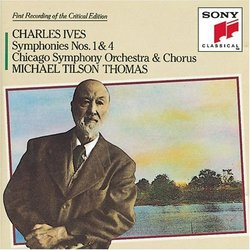 | Charles Ives, Simeon Butler Marsh, Lowell Mason Ives: Symphonies Nos. 1 & 4/Hymns Genres: Pop, Classical
Ives's First Symphony is an attractive, conservative piece with a gorgeous slow movement based on a hymn tune and a finale that sounds strangely like early Bruckner. The Fourth, on the other hand, is arguably his masterp... more » |
Larger Image |
CD DetailsSynopsis
Amazon.com essential recording Ives's First Symphony is an attractive, conservative piece with a gorgeous slow movement based on a hymn tune and a finale that sounds strangely like early Bruckner. The Fourth, on the other hand, is arguably his masterpiece, and one of the most radical compositions in the history of music. Scored for a huge orchestra with three solo pianos, chorus, offstage and onstage instruments, and "everything but the kitchen sink" percussion, it requires at least two conductors to keep it all coordinated. Listening to it--despite the commotion in the second movement--is a positively transcendental experience, and the finale resolves itself into one of the most beautiful moments in American music. These performances are smashing (and crashing, where necessary!). --David Hurwitz Similar CDs
Similarly Requested CDs |
CD ReviewsStunning Recording/Performance/Interpretation George John | Houston, TX United States | 03/20/2002 (5 out of 5 stars) "I caught the Ives "bug" in 70's while in college. I heard the Houston Symphony and Lawrence Foster perform the 4th live in Jones Hall. While completely baffled by much of what I heard, I knew I had to learn more about this composer. I bought and listened to as many LP's as I could afford, among them was the Ormandy/Philadelphia 1st and Stokowski/American Symphony 4th on Columbia. I was fond of both the 1st and 4th, but set them both aside until recently. I listened to them both, found that I still enjoyed them very much, but found both lacking from a sound quality point of view. I searched the Web and found glowing reviews of this CD. Well, the reviews are 100% justified. This CD will quite possibly become my favorite in my collection. Pairing the 1st and the 4th makes sense. George Ives told his son, "You have to learn the rules before you can break them". The 1st clearly shows that Ives learned the rules admirably. The work is both moving at times and tremendous fun. Take a young, creative, and relatively uninhibited musical genius, expose him to the great European masters like Brahms, Dvorak, Wagner, and Beethoven, mix in church hymns, American folk and band music, and you will get the Ives 1st Symphony.Comparing the Ormandy to the Tilson Thomas, while I'm very fond of the Ormandy reading, I find the Tilson Thomas to be overall significantly more satisfying. The Ives 1st is a technically challenging work particularly for the 1st violins. Except for a few very minor flaws, the CSO strings meet the challenge. Tilson Thomas extracts more of the music from the score. The recording engineers get an A+ for overall balance and sound. This is a fine, very accessible work which deserves many more performances in the concert hall than what I suspect it currently gets.Between the First and Fourth are performances of five hymns that are used in the Fourth - a nice bonus.It's difficult for me to discuss the Ives Fourth. I have been a fan of the work since I first heard it. The third, slow movement is a reworking of the first movement of the First String Quartet. It's accessible, beautiful, and deeply moving. The other three movements are experimental music at its all time best -- powerful, baffling, mysterious, chaotic, and profoundly moving. This music arguably could have been an intellectual exercise only, but somehow completely transcends this, and becomes something which I can only, given my limitations as a music listener, view with great awe and mystery. For me this music is completely engaging, fascinating, transports me at times into an altered state of mind that I can't even begin to describe, and ultimately moves me to the strongest and most deeply felt of emotions.I considered this work to be a masterpiece in a category all by itself. If there are other works like this one, I want to know about them, please.I give this release the highest of all possible recommendations. The attention to detail and how successfully it has been captured on disk is simply amazing." A Fine Ives CD! George John | 03/06/2000 (5 out of 5 stars) "If you are collecting Ives' symphonies, this is a sensitive, clean and appealing performance of No. 1. The inclusion of five old American church hymns on this CD is an interesting idea. While I doubt anyone will buy this CD for these hymns, I appreciate the concept of inserting them as a prelude to Ives' Sym. No. 4, since Ives does quote these particular hymns in the symphony. As for Sym. No. 4: I loved my old vinyl recording, but I love this CD even more! Conductors might interpret this extremely complex music in varying ways, but somehow No. 4 conveys its unmistakeable "message" in every recording I've heard. Ives' genius was truly unique. A native of Danbury CT, he was experimenting with polyrhythms, quarter-tones, and free atonalism long before Schoenberg and Stravinsky brought them into style. Has any other composer so daringly and so successfully raised such humble materials to such a sublime level? How can two marching bands playing different pieces at the same time be so right? How can chaos make such perfect sense? Somehow Ives makes disorder into something transcendently perfect, and yes...piercingly beautiful. The final movement might provoke a mystical vision if you're not careful. Michael Tilson Thomas truly loves modern music, and it shows in this recording. He brings out the Emersonian-mystical quality of Ives' music very effectively, but also utilizes the power of the C.S.O. to emphasize the surprising muscle beneath this music, which I had not noticed in other recordings. As you might expect with the C.S.O., the performance is precise (perhaps a strange term to use with this symphony) but also emotionally charged. The chorus does a beautiful job with its haunting, critical role in the 1st and last movements. I recommend this CD highly, and hope it will help more people appreciate Ives' genius." Detail of Ives's Evolution over Time A. Michaelson | Bay Area, CA | 03/25/2004 (5 out of 5 stars) "This CD consists of the Charles Ives's first and last symphonies. The first is a work that Ives wrote as his thesis while a music student at Yale. It demonstrates Ives's mastery of the late 19th century style. It's an interesting and thoroughly engaging work of music, but nothing spectacular. The real highlight of this disc is the 4th symphony, which is probably the best played version of this piece currently available. The fourth is Ives's most ambitious and experimental work. It experiments with atonality, polytonality, polyryhthms, and the layering of multiple orchestras (or at least the impression of layering multiple orchestras). Plus, in typical Ives fashion, the fourth includes numerous quotes to popular American music of his time, especially marches and ragtime. What sets this recording of the fourth apart from the numerous others that are available is its Americanness. The other available recordings are conducted by non-Americans who don't seem to have a real grasp of the uniquely American qualities of this piece. Other recordings tend to suffer from a very modernist approach. The playing is precise and the multiple textures are very clear...however, that's not the point of this piece. MTT makes this piece swing, which is exactly how it's supposed to be played. Listen to the quotes from ragtime and marches in other versions of this piece as compared to the ragtime and american marches in this recording. This recording sounds very American and captures the essence of turn of the century American music, wheras the other recordings play this swinging music as if it were an excercise in precision conducting. Yes, if you want to hear the music played with precise and clearly articulated textures, go for the Ozawa recording. If you want to hear the fourth as the revolutionary piece of music that celebrates America, as Ives meant to be heard, then pick up this recording."
|

 Track Listings (13) - Disc #1
Track Listings (13) - Disc #1